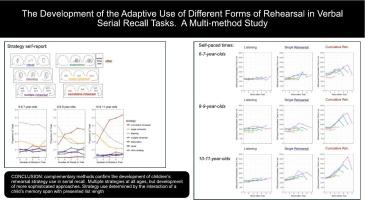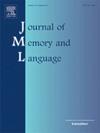不同形式的排练在言语序列回忆任务中的适应性运用。多方法研究
IF 3
1区 心理学
Q1 LINGUISTICS
引用次数: 0
摘要
语言排练是某些工作记忆模型的一个关键特征,这些模型先前假设儿童在7岁左右发展出像成人一样的排练能力。然而,更广泛的文献表明,年幼的孩子有能力排练。本研究以191名小学生为研究对象,采用两种常用的方法对连续记忆中的排练进行研究。自定的陈述时间被作为策略使用的行为指标。在一半的试验中,孩子们通过大声思考(见图1)或直接一次又一次的自我报告(见图1)来报告他们的策略。2). 实验1中对10- 11岁儿童采用的三种方法的结果一致表明,在不同的试验中使用了多种策略。聆听、单一排练和累积排练是有效报告的常见策略,对策略报告的反应性没有或只有很小的影响。实验2显示,6至11岁的儿童在不同的试验中采用了一系列的策略。在低龄儿童中,不排练的听是常见的,累积排练是罕见的,但累积排练和对列表长度的策略适应性随着年龄的增长而逐渐增加。重要的是,即使在年幼的孩子中,自我报告也得到了自我呈现次数的证实。我们的结论是,排练的发展并不遵循一个阶段式的进展。相反,数据支持重叠波模型,因为几种策略共存,使用策略的可能性逐渐变化,并且策略选择的适应性在较大的儿童中仍然提高。本文章由计算机程序翻译,如有差异,请以英文原文为准。

The development of the adaptive use of different forms of rehearsal in verbal serial recall tasks. A multi-method study
Verbal rehearsal is a key feature of certain working memory models that have previously assumed that children develop adult-like rehearsal around the age of 7. However, a broader literature indicates that younger children are capable of rehearsal. The present study, consisting of two experiments with 191 primary school children in total, combined methods that are rarely used to study rehearsal in serial recall. Self-paced presentation times were obtained as a behavioural indicator of strategy use. On half of trials, children additionally reported their strategies via think-aloud (Expt. 1) or immediate trial-by trial self-reports (Expt. 1 & 2). Results from the three methods employed in Experiment 1 with 10- to 11-year-olds converged on the conclusion that multiple strategies were used across trials. Listening, single rehearsal, and cumulative rehearsal were common strategies that were validly reported with no or only small effects of reactivity of strategy reporting. Experiment 2 revealed that between the ages of 6 to 11 years children employed a range of strategies across trials. Listening without rehearsal was common and cumulative rehearsal rare among the younger children, but cumulative rehearsal and strategy adaptivity to list length gradually increased with age. Importantly, self-reports were corroborated by self-presentation times even in younger children. We conclude that rehearsal development does not follow a stage-like progression. Rather, the data support an overlapping waves model as several strategies coexist, the likelihood of using a strategy changes gradually, and adaptivity of strategy choices still improves among older children.
求助全文
通过发布文献求助,成功后即可免费获取论文全文。
去求助
来源期刊
CiteScore
8.70
自引率
14.00%
发文量
49
审稿时长
12.7 weeks
期刊介绍:
Articles in the Journal of Memory and Language contribute to the formulation of scientific issues and theories in the areas of memory, language comprehension and production, and cognitive processes. Special emphasis is given to research articles that provide new theoretical insights based on a carefully laid empirical foundation. The journal generally favors articles that provide multiple experiments. In addition, significant theoretical papers without new experimental findings may be published.
The Journal of Memory and Language is a valuable tool for cognitive scientists, including psychologists, linguists, and others interested in memory and learning, language, reading, and speech.
Research Areas include:
• Topics that illuminate aspects of memory or language processing
• Linguistics
• Neuropsychology.

 求助内容:
求助内容: 应助结果提醒方式:
应助结果提醒方式:


